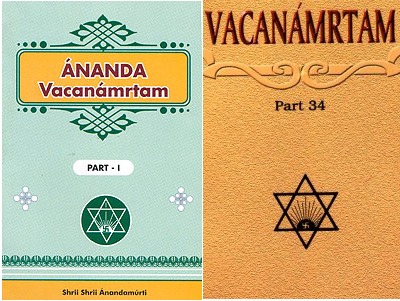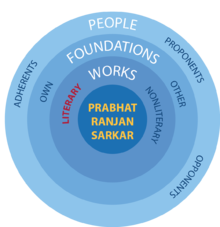Ananda Vacanamrtam: Difference between revisions
(Fmt) |
(Grammar changes) |
||
| (12 intermediate revisions by 2 users not shown) | |||
| Line 3: | Line 3: | ||
| name = Ananda Vacanamrtam <br/>(Parts 1 to 34) | | name = Ananda Vacanamrtam <br/>(Parts 1 to 34) | ||
| image = [[File:Ananda Vacanamrtam Vol 1 to 34.jpg]] | | image = [[File:Ananda Vacanamrtam Vol 1 to 34.jpg]] | ||
| | | caption = "Ananda Vacanamrtam": the front covers of Parts 1 and 34<ref group=note>{{cite web|url=http://shop.anandamarga.org/books/sarkar/av.htm |title=Ananda Vacanamrtam Part 1 as it appears on the publisher's site|publisher=Ananda Marga Publication |date= |accessdate=23 December 2012}}</ref><ref group=note>{{cite web|url=http://shop.anandamarga.org/books/sarkar/av.htm |title=Ananda Vacanamrtam Part 34 as it appears on the publisher's site|publisher=Ananda Marga Publication |date= |accessdate=23 December 2012}}</ref> | ||
| author = [[Prabhat Ranjan Sarkar|Shrii Shrii Anandamurti]] | | author = [[Prabhat Ranjan Sarkar|Shrii Shrii Anandamurti]] | ||
| title_orig = | | title_orig = | ||
| Line 10: | Line 10: | ||
| cover_artist = | | cover_artist = | ||
| country = | | country = | ||
| language = | | language = English | ||
| series = | | series = | ||
| subject = [[:wikipedia:Philosophy|Philosophy]] | | subject = [[:wikipedia:Philosophy|Philosophy]] | ||
| Line 26: | Line 26: | ||
| followed_by = | | followed_by = | ||
}} | }} | ||
'''''Ananda Vacanamrtam''''' ("Blissful Discourses") is a series of 34 books, part of the vast literary heritage of the author, that assembles all the known ''General Darshan'' (GD) discourses<ref group=note>''General Darshans'' were speeches regularly helded by Shrii Shrii Anandamurti and dedicated to the Ananda Marga's members.</ref> given by the [[:wikipedia:Philosophy|philosopher]] and social reformer [[Prabhat Ranjan Sarkar]] aka Shrii Shrii Anandamurti (1921–1990).<ref group=note>Between 1955 and 1990 the author wrote in | '''''Ananda Vacanamrtam''''' ("Blissful Discourses") is a series of 34 books, part of the vast literary heritage of the author, that assembles all the known ''General Darshan'' (GD) discourses<ref group=note>''General Darshans'' were speeches regularly helded by Shrii Shrii Anandamurti and dedicated to the Ananda Marga's members.</ref> given by the [[:wikipedia:Philosophy|philosopher]] and social reformer [[Prabhat Ranjan Sarkar]] aka Shrii Shrii Anandamurti (1921–1990).<ref group=note>Between 1955 and 1990 the author wrote in English, [[:wikipedia:Bengali language|Bengali]] and [[:wikipedia:Hindi language|Hindi]]. He wrote in the name "Shrii Prabhat Ranjan Sarkar" when treating [[:wikipedia:Sociology|sociology]], [[:wikipedia:Economics|economics]], [[:wikipedia:Philology|philology]] and various other subjects, and in the name ""Shrii Shrii Ánandamúrti"" when focusing on spiritual topics. Many of his books he gave as dictations; others were compiled from his discourses, some of them in small pocket-books.</ref> | ||
These kind of discourses are generally briefer than those given during the more formal occasion of the ''Dharma Maha Chakra'' (DMC)<ref group=note>A spiritual [[:wikipedia:Ceremony|ceremony]] where the disciples [[:wikipedia:meditation|meditate]] in the presence of the [[:wikipedia:Guru|Master]] and He holds an important spiritual discourse and performs a special ''[[:wikipedia:Mudra|Mudra]]'' named ''Varabaja Mudra''.</ref> which are collected on the ''[[Subhasita Samgraha]]'' series of books. | |||
== Contents == | == Contents == | ||
The range of topics | The range of topics encompass the sphere of spirituality and intuitional science. This series of books was begun in 1978 with "''Ananda Vacanamrtam'' Part 1" starting with the discourse "The Secret behind Colours"{{sfn|Anandamurti |1978|p=5}} given by the author on August 5, 1978 in [[:wikipedia:Patna|Patna]] (India). This discourse was followed from the General Darshan speeches that the author gave over the subsequent six years. | ||
Starting with Part 23, the series has included | Starting with Part 23, the series has included General Darshan speeches given before 1978. | ||
In | In the fourth discourse of Part 34,{{sfn|Anandamurti|1978|}} Anandamurti explains how the mind expands due to ''Tantra sadhana'', intending this ''sadhana'' as a fundamental fight between the spiritual [[:wikipedia:force|force]] and the debasing material force. Here the author also considers ''Tantra'' as a "cult", defining "cult" as a subjective approach towards the "Supreme Subject". In this process, ''tantrics'' have necessarily to face themselves with the worldly things, i.e. the world of objectivities. It's therefore necessary for a spiritualist to adopt what the author calls a "subjective approach and objective adjustment". | ||
Marcus Bussey<ref group=note>[[:wikipedia:University of the Sunshine Coast|University of the Sunshine Coast]], [[:wikipedia:Australia|Australia]].</ref> | Marcus Bussey<ref group=note>[[:wikipedia:University of the Sunshine Coast|University of the Sunshine Coast]], [[:wikipedia:Australia|Australia]].</ref> quotes Anandamurti's concept.{{sfn|Bussey|2006}} Speaking about the [[:wikipedia:Heidegger|Heidegger]]'s concept of "[[:wikipedia:Dasein|Dasein]],<ref group=note>i.e. the Heidegger's [[:wikipedia:existential philosophy|existential philosophy]] concept of "''Dasein''"=German: ''da'' - here; ''sein'' - being.</ref> of the cultural condition as opposed to the individual one, that Bussey considers as very interesting from the point of view of [[:wikipedia:Futures studies|futurist]]s research, to better understand [[:wikipedia:social change|social change]] and its link with personal transformation.<ref group=note>The scholar asks himself: "if we switch civilisational lens, when looking at the Tantric social philosophy of P.R. Sarkar, can we engage his understanding of subjective approach through objective adjustment with the "''Dasein''" that is simultaneously active and passive and able to sustain the paradox of such a condition?</ref> | ||
The series ends with | The series ends with Discourse 22, "The Best Mental Engagement", given by the author on May 28, 1988 in [[:wikipedia:Anandanagar|Anandanagar]] ([[:wikipedia:India|India]]n [[:wikipedia:States and territories of India|state]] of [[:wikipedia:West Bengal|West Bengal]]). It is a short discourse in which Anandamurti explains the spiritual meaning of the [[:wikipedia:Chaitanya Mahaprabhu|Chaitanya Mahaprabhu]]'s [[:wikipedia:shloka|shloka]]: | ||
<center><poem>''Trńádapi suniicena taroriva sahiśńuná;'' | |||
''Amániinaḿ mánadena kiirtaniyah sadá Harih.''</poem></center> | |||
(You must be more humble than the [[:wikipedia:grass|grass]] and as [[:wikipedia:Toleration|tolerant]] as the [[:wikipedia:tree|tree]]s. You must give [[:wikipedia:respect|respect]] to those whom no one respects, and always do [[:wikipedia:Kirtan|kiirtana]] to the [[:wikipedia:Names of God|Lord]].) | (You must be more humble than the [[:wikipedia:grass|grass]] and as [[:wikipedia:Toleration|tolerant]] as the [[:wikipedia:tree|tree]]s. You must give [[:wikipedia:respect|respect]] to those whom no one respects, and always do [[:wikipedia:Kirtan|kiirtana]] to the [[:wikipedia:Names of God|Lord]].) | ||
| Line 50: | Line 50: | ||
=== Sources === | === Sources === | ||
* {{cite book|title=Ananda Vacanamrtam Part 1 to 34 |last={{aut|[[Prabhat Ranjan Sarkar|Anandamurti]]}}|first={{aut|[[Prabhat Ranjan Sarkar|Shrii Shrii]]}} |location=Kolkata |publisher= Ananda Marga-Ananda Printers |year=1978}} | * {{cite book|title=Ananda Vacanamrtam Part 1 to 34 |last={{aut|[[Prabhat Ranjan Sarkar|Anandamurti]]}}|first={{aut|[[Prabhat Ranjan Sarkar|Shrii Shrii]]}} |location=Kolkata |publisher= Ananda Marga-Ananda Printers |year=1978}} | ||
* {{citation|url=http://www.academia.edu/488910/The_Paradox_of_Being_Dasein_as_a_Potential_Ground_for_Futures_Work |last= {{aut|Bussey}} |first= {{aut|Marcus}} |title= The Paradox of Being: Dasein as a Potential "Ground" for Futures Work |journal= Journal of Futures Studies |volume= 10(4) |pages= 91–94 |date= May 2006 |year= 2006}|accessdate=1 January 2013}} | * {{citation|url=http://www.academia.edu/488910/The_Paradox_of_Being_Dasein_as_a_Potential_Ground_for_Futures_Work |last= {{aut|Bussey}} |first= {{aut|Marcus}} |title= The Paradox of Being: Dasein as a Potential "Ground" for Futures Work |journal= Journal of Futures Studies |volume= 10(4) |pages= 91–94 |date= May 2006 |year= 2006}|accessdate=1 January 2013}} | ||
* {{cite web|url=http://shop.anandamarga.org/ |year= 2012 |last={{aut|Ananda Marga Publications}} |publisher= Ananda Marga Publications |title= Web site |accessdate= 3 January 2013}} | * {{cite web|url=http://shop.anandamarga.org/ |year= 2012 |last={{aut|Ananda Marga Publications}} |publisher= Ananda Marga Publications |title= Web site |accessdate= 3 January 2013}} | ||
{{Portal|Ananda Vacanamrtam}} | |||
{{Ananda Vacanamrtam}} | |||
[[Category: | [[Category:Literary works of Prabhat Ranjan Sarkar]] | ||
[[Category:Ananda Vacanamrtam]] | |||
Latest revision as of 05:29, 9 March 2015
| Ananda Vacanamrtam (Parts 1 to 34) | |
|---|---|
 | |
| Author | Shrii Shrii Anandamurti |
| Language | English |
| Subject | Philosophy |
| Publisher | Ananda Marga Publications |
| Publication date | 1978 (first edition) (IND) |
| Media type | |
| Location in Sarkarverse | |
Ananda Vacanamrtam ("Blissful Discourses") is a series of 34 books, part of the vast literary heritage of the author, that assembles all the known General Darshan (GD) discourses[note 3] given by the philosopher and social reformer Prabhat Ranjan Sarkar aka Shrii Shrii Anandamurti (1921–1990).[note 4] These kind of discourses are generally briefer than those given during the more formal occasion of the Dharma Maha Chakra (DMC)[note 5] which are collected on the Subhasita Samgraha series of books.
Contents
The range of topics encompass the sphere of spirituality and intuitional science. This series of books was begun in 1978 with "Ananda Vacanamrtam Part 1" starting with the discourse "The Secret behind Colours"[1] given by the author on August 5, 1978 in Patna (India). This discourse was followed from the General Darshan speeches that the author gave over the subsequent six years. Starting with Part 23, the series has included General Darshan speeches given before 1978.
In the fourth discourse of Part 34,[2] Anandamurti explains how the mind expands due to Tantra sadhana, intending this sadhana as a fundamental fight between the spiritual force and the debasing material force. Here the author also considers Tantra as a "cult", defining "cult" as a subjective approach towards the "Supreme Subject". In this process, tantrics have necessarily to face themselves with the worldly things, i.e. the world of objectivities. It's therefore necessary for a spiritualist to adopt what the author calls a "subjective approach and objective adjustment". Marcus Bussey[note 6] quotes Anandamurti's concept.[3] Speaking about the Heidegger's concept of "Dasein,[note 7] of the cultural condition as opposed to the individual one, that Bussey considers as very interesting from the point of view of futurists research, to better understand social change and its link with personal transformation.[note 8]
The series ends with Discourse 22, "The Best Mental Engagement", given by the author on May 28, 1988 in Anandanagar (Indian state of West Bengal). It is a short discourse in which Anandamurti explains the spiritual meaning of the Chaitanya Mahaprabhu's shloka:
Trńádapi suniicena taroriva sahiśńuná;
Amániinaḿ mánadena kiirtaniyah sadá Harih.
(You must be more humble than the grass and as tolerant as the trees. You must give respect to those whom no one respects, and always do kiirtana to the Lord.)
References
Footnotes
- ^ "Ananda Vacanamrtam Part 1 as it appears on the publisher's site" Ananda Marga Publication retrieved 23 December 2012
- ^ "Ananda Vacanamrtam Part 34 as it appears on the publisher's site" Ananda Marga Publication retrieved 23 December 2012
- ^ General Darshans were speeches regularly helded by Shrii Shrii Anandamurti and dedicated to the Ananda Marga's members.
- ^ Between 1955 and 1990 the author wrote in English, Bengali and Hindi. He wrote in the name "Shrii Prabhat Ranjan Sarkar" when treating sociology, economics, philology and various other subjects, and in the name ""Shrii Shrii Ánandamúrti"" when focusing on spiritual topics. Many of his books he gave as dictations; others were compiled from his discourses, some of them in small pocket-books.
- ^ A spiritual ceremony where the disciples meditate in the presence of the Master and He holds an important spiritual discourse and performs a special Mudra named Varabaja Mudra.
- ^ University of the Sunshine Coast, Australia.
- ^ i.e. the Heidegger's existential philosophy concept of "Dasein"=German: da - here; sein - being.
- ^ The scholar asks himself: "if we switch civilisational lens, when looking at the Tantric social philosophy of P.R. Sarkar, can we engage his understanding of subjective approach through objective adjustment with the "Dasein" that is simultaneously active and passive and able to sustain the paradox of such a condition?
Citations
- ^ Anandamurti 1978, p. 5.
- ^ Anandamurti 1978.
- ^ Bussey 2006.
Sources
- Anandamurti, Shrii Shrii (1978) Ananda Vacanamrtam Part 1 to 34 Kolkata: Ananda Marga-Ananda Printers
- Bussey, Marcus (May 2006), "The Paradox of Being: Dasein as a Potential "Ground" for Futures Work", Journal of Futures Studies, 10(4): 91–94, retrieved 1 January 2013
- Ananda Marga Publications (2012) "Web site" Ananda Marga Publications retrieved 3 January 2013
